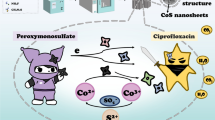Abstract
Objectives
To improve the Pb2+ biosorption capacity of the potential E. coli biosorbent, a putative Pb2+ binding domain (PbBD) derived from PbrR was efficiently displayed on to the E. coli cell surface.
Results
The PbBD was obtained by truncating the N-terminal DNA-binding domain and C-terminal redundant amino acid residues of the Pb2+-sensing transcriptional factor PbrR. Whole-cell sorbents were constructed with the full-length PbrR and PbBD of PbrR genetically engineered onto the surface of E. coli cells using Lpp-OmpA as the anchor. Followed by a 1.71-fold higher display of PbBD than PbrR, the presence of PbBD on the surface of E. coli cells enabled a 1.92-fold higher Pb2+ biosorption than that found in PbrR-displayed cells. Specific Pb2+ binding via PbBD was the same as Pb2+ binding via the full-length PbrR, with no observable decline even in the presence of Zn2+ and Cd2+.
Conclusions
Since surface-engineered E. coli cells with PbBD increased the Pb2+ binding capacity and did not affect the adsorption selectivity, this suggests that surface display of the metal binding domain derived from MerR-like proteins may be used for the bioremediation of specific toxic heavy metals.





Similar content being viewed by others
References
Bae W, Wu CH, Kostal J, Mulchandani A, Chen W (2003) Enhanced mercury biosorption by bacterial cells with surface-displayed MerR. Appl Environ Microb 69:3176–3180
Biasini M, Bienert S, Waterhouse A, Arnold K et al (2014) SWISS-MODEL: modelling protein tertiary and quaternary structure using evolutionary information. Nucl Acids Res 42:W252–258
Borremans B, Hobman JL, Provoost A, Brown NL, van Der Lelie D (2001) Cloning and functional analysis of the pbr lead resistance determinant of Ralstonia metallidurans CH34. J Bacteriol 183:5651–5658
Chang CC, Lin LY, Zou XW, Huang CC, Chan NL (2015) Structural basis of the mercury(II)-mediated conformational switching of the dual-function transcriptional regulator MerR. Nucl Acids Res 43:7612–7623
Chen P, Greenberg B, Taghavi S, Romano C, van der Lelie D, He C (2005) An exceptionally selective lead(II)-regulatory protein from Ralstonia metallidurans: development of a fluorescent lead(II) probe. Angew Chem Int Ed Engl 44:2715–2719
Fernandez-Lopez R, Ruiz R, de la Cruz F, Moncalian G (2015) Transcription factor-based biosensors enlightened by the analyte. Front Microbiol 6:648
Guo HB, Johs A, Parks JM, Olliff L, Miller SM, Summers AO, Liang L, Smith JC (2010) Structure and conformational dynamics of the metalloregulator MerR upon binding of Hg(II). J Mol Biol 398:555–568
Janssen PJ, Van Houdt R, Moors H, Monsieurs P et al (2010) The complete genome sequence of Cupriavidus metallidurans strain CH34, a master survivalist in harsh and anthropogenic environments. PLoS ONE 5:e10433
Ko KC, Lee B, Cheong DE, Han Y, Choi JH, Song JJ (2015) Bacterial cell surface display of a multifunctional cellulolytic enzyme screened from a bovine rumen metagenomic resource. J Microbiol Biotechnol 25:1835–1841
Manzoor R, Zhang T, Zhang X, Wang M, Pan JF, Wang Z, Zhang B (2017) Single and combined metal contamination in coastal environments in China: current status and potential ecological risk evaluation. Environ Sci Pollut Res Int 25:1044–1054
Outten CE, Outten FW, O’Halloran TV (1999) DNA distortion mechanism for transcriptional activation by ZntR, a Zn(II)-responsive MerR homologue in Escherichia coli. J Biol Chem 274:37517–37524
Permina EA, Kazakov AE, Kalinina OV, Gelfand MS (2006) Comparative genomics of regulation of heavy metal resistance in Eubacteria. BMC Microbiol 6:49
Saleem M, Brim H, Hussain S, Arshad M, Leigh MB (2008) Perspectives on microbial cell surface display in bioremediation. Biotechnol Adv 26:151–161
Song L, Caguiat J, Li Z, Shokes J, Scott RA, Olliff L, Summers AO (2004) Engineered single-chain, antiparallel, coiled coil mimics the MerR metal binding site. J Bacteriol 186:1861–1868
Sousa C, Cebolla A, de Lorenzo V (1996) Enhanced metalloadsorption of bacterial cells displaying poly-His peptides. Nat Biotechnol 14:1017–1020
Stoyanov JV, Hobman JL, Brown NL (2001) CueR (YbbI) of Escherichia coli is a MerR family regulator controlling expression of the copper exporter CopA. Mol Microbiol 39:502–511
Tao HC, Peng ZW, Li PS, Yu TA, Su J (2013) Optimizing cadmium and mercury specificity of CadR-based E. coli biosensors by redesign of CadR. Biotechnol Lett 35:1253–1258
Valls M, Atrian S, de Lorenzo V, Fernandez LA (2000) Engineering a mouse metallothionein on the cell surface of Ralstonia eutropha CH34 for immobilization of heavy metals in soil. Nat Biotechnol 18:661–665
Wang JY, Chao YP (2006) Immobilization of cells with surface-displayed chitin-binding domain. Appl Environ Microb 72:927–931
Wei W, Liu X, Sun P, Wang X, Zhu H, Hong M, Mao ZW, Zhao J (2014) Simple whole-cell biodetection and bioremediation of heavy metals based on an engineered lead-specific operon. Environ Sci Technol 48:3363–3371
Acknowledgements
This research was supported by Natural Science Foundation of Guangdong Province (2015A030313838), and Science and Technology Program of Shenzhen (JCYJ20150403091305481).
Supporting information
Supplementary Table 1—Bacterial strains and plasmids used in this study.
Supplementary Fig. 1—Amino acid sequence of Pb2+ binding domain (PbBD) of PbrR and the codon optimized DNA sequence.
Supplementary Fig. 2—The growth curves of E. coli BL21(DE3) harboring pLA, pLAP, and pLAPB.
Author information
Authors and Affiliations
Corresponding author
Electronic supplementary material
Below is the link to the electronic supplementary material.
Rights and permissions
About this article
Cite this article
Hui, CY., Guo, Y., Yang, XQ. et al. Surface display of metal binding domain derived from PbrR on Escherichia coli specifically increases lead(II) adsorption. Biotechnol Lett 40, 837–845 (2018). https://doi.org/10.1007/s10529-018-2533-4
Received:
Accepted:
Published:
Issue Date:
DOI: https://doi.org/10.1007/s10529-018-2533-4




